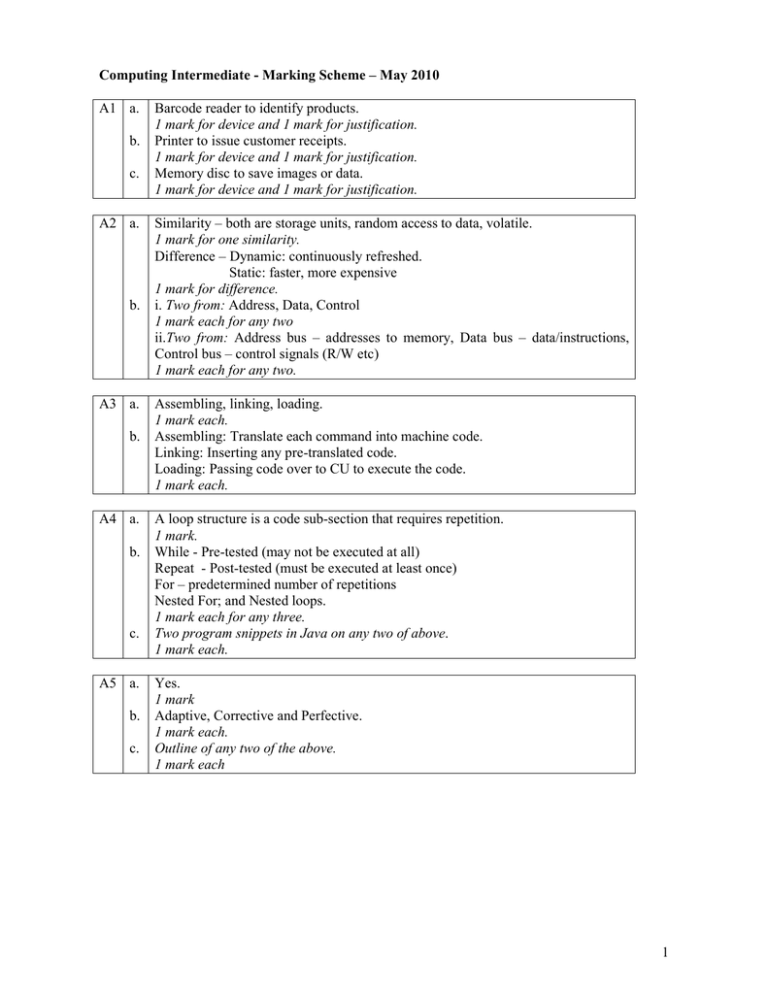A1 a. Barcode reader to identify products. b.
advertisement

Computing Intermediate - Marking Scheme – May 2010 A1 a. b. c. A2 a. b. A3 a. b. A4 a. b. c. A5 a. b. c. Barcode reader to identify products. 1 mark for device and 1 mark for justification. Printer to issue customer receipts. 1 mark for device and 1 mark for justification. Memory disc to save images or data. 1 mark for device and 1 mark for justification. Similarity – both are storage units, random access to data, volatile. 1 mark for one similarity. Difference – Dynamic: continuously refreshed. Static: faster, more expensive 1 mark for difference. i. Two from: Address, Data, Control 1 mark each for any two ii.Two from: Address bus – addresses to memory, Data bus – data/instructions, Control bus – control signals (R/W etc) 1 mark each for any two. Assembling, linking, loading. 1 mark each. Assembling: Translate each command into machine code. Linking: Inserting any pre-translated code. Loading: Passing code over to CU to execute the code. 1 mark each. A loop structure is a code sub-section that requires repetition. 1 mark. While - Pre-tested (may not be executed at all) Repeat - Post-tested (must be executed at least once) For – predetermined number of repetitions Nested For; and Nested loops. 1 mark each for any three. Two program snippets in Java on any two of above. 1 mark each. Yes. 1 mark Adaptive, Corrective and Perfective. 1 mark each. Outline of any two of the above. 1 mark each 1 A6 a. b. c. A7 a. b. c. A8 a. b. Improved data consistency and portability, control over redundancy, greater security. 1 mark each for any two. To reduce duplicate data. 1 mark i. Object-Oriented, Hierarchical, Network models. 1 mark for any one ii. Relational is the linking of two or more files together; while O-O’s are those that accept objects. 1 mark each. Three relevant fields from Students and Books tables. 1½ marks for 3 fields in each table. Relevant primary key in each table with justification. 1 mark for key and 1 mark for justification. Transactions or Loans – table to identify student with book borrowed. 1 mark E+Ā+Ō 2 marks for correct literals; 1 mark for correct ‘Ors’; 1 mark for correct ‘Nots’. Vide truth table below. 1 mark for each correct last two columns. A 0 0 1 1 A9 (A + E) 1 0 0 0 (Ā.Ē) 1 0 0 0 a. i. Computer control of a machine through automatic response to the feedback signals from sensors. 1 mark. ii. 1 mark for a relevant situation. 1mark for brief explanation. b. i. File access restriction or other relevant reason. 1 mark ii. Using alphanumeric, change frequently or other relevant answers. 1 mark each for any two. A10 a. b. c. B1 E 0 1 0 1 a. Metropolitan Area Network, Wide Area Network. 1mark for both Geographical area and other relevant answer. 1 mark each for any two. One relevant situation for each of the 3 types of network. 1 mark each. i. E-Learning is a term that encompasses all forms of Technology-Enhanced Learning (TEL) or very specific types of TEL such as online or Web-based learning. 2 marks ii. Web-based tuition and other relevant example. 2 marks 2 b. c. B2 a. b. c. i. E-learning is considered a complementary form to face-to-face (F2F) learning which by far the most effective style and most traditional. 2 marks each for two differences ii. E-learning proceeds at the pace of the student. F2F is personalised with a human touch. 1 mark each iii. E-learning requires students to have a computer. F2F can be done anywhere and depends solely on the student. 1 mark each i. Relevant explanation of Virtual Learning Environment 2 marks ii. WebCT, Blackboard, Moodle or other relevant answers. 1 mark each for any three. iii. Three from Podcasts, Presentations, Tutorials, Videos, Course notes. 1 mark each for any three. i. Allows different computers from different suppliers, located anywhere to communicate with each other. 1 mark ii. Application layer, Transport layer, Network layer and Data Link layer. 1 mark each • Application layer: Provides application access to the communication environment; • Transport layer: divides the data passed to it from the application layer into packets for the network layer to send; • Network layer: the IP provides source and destination addressing, sequencing and routing in the TCP/IP suite; • Data Link layer: handles the physical details of interfacing with the cable. 1 mark each iii. Allows messages to travel from one part of a network to another. A relevant example. 1 mark for explanation. 1mark for example. iv. First part - Network address. Second part - Host address. 1 mark each v. 32 or 128 for IPv6. 1 mark i. Domain Name System. 1 mark ii. To assign a host name to every device on the Internet corresponding to the IP address. 2 marks Circuit – a dedicated physical path exists between sending and receiving computers Message – a permanent path is set up between two node computers which may be used for short-duration messages Packet – a message switching network in which messages are split up into packets ready for transmission 1 mark each 3








